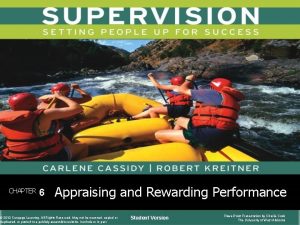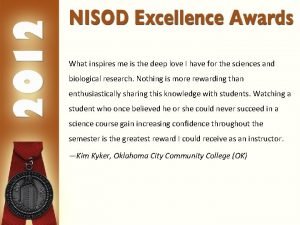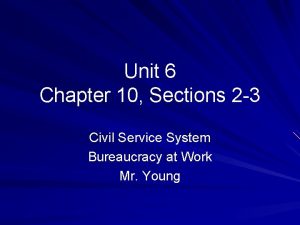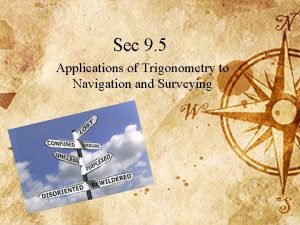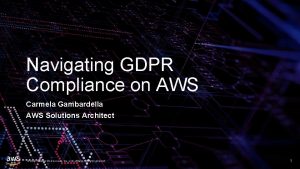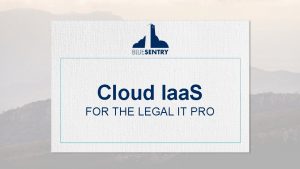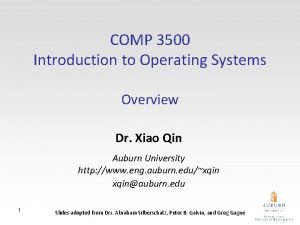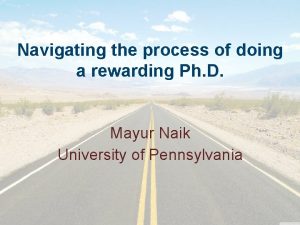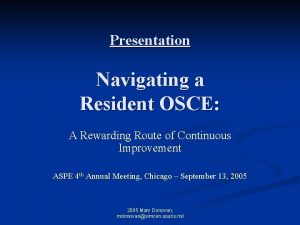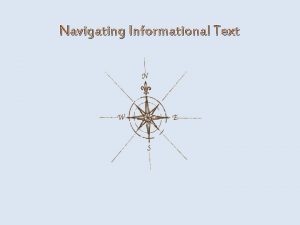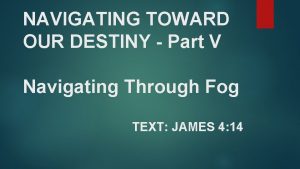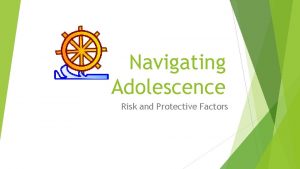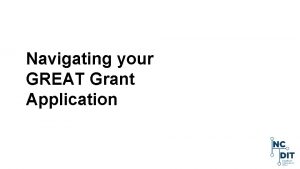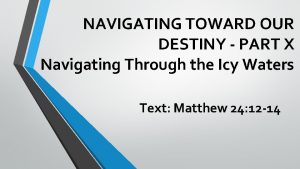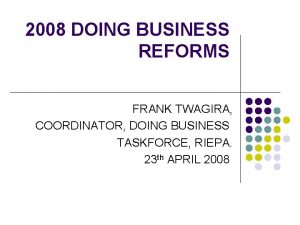Navigating the process of doing a rewarding Ph






























- Slides: 30

Navigating the process of doing a rewarding Ph. D. Mayur Naik University of Pennsylvania

My Background � 2003 -08: Ph. D, Stanford Thesis: Effective Static Race Detection for Java Advisor: Alex Aiken � 2008 -11: Research Scientist, Intel Labs, Berkeley � 2011 -16: Assistant Professor, Georgia Tech � 2016 - 2 : Associate Professor, Univ. of Pennsylvania PLMW @ SPLASH 6/3/2021

My Background � Research: Automated techniques and tools for improving software reliability Chord Conchor Prism Cirrus. Clou Nichrome Petablox program d configurabl d solver for program analysis e program mobilemixed hard analysis for platform of analysis cloud and soft Big Code for Java concurre computing constraints nt � Teaching: Software Analysis and Testing programs � Online on Udacity, taken by ~ 500 students worldwide each year 3 PLMW @ SPLASH 6/3/2021

The Ph. D Process �Take core courses (breadth requirement) �Choose an advisor / area �Learn how to do research �Write your first paper �Pass area qualifiers (depth requirement) �Pick a thesis topic and propose �Defend thesis and write dissertation �Search for a job and graduate 4 PLMW @ SPLASH 6/3/2021

Why Take Courses? �Helps broaden you as a researcher �Could help in picking advisor / area �Could provide ideas in your research later �Helps in academic job interviews �Unlikely to get the time / opportunity later 5 PLMW @ SPLASH 6/3/2021

Choosing an Advisor and Area � Be aware of matching process in the department � Informal match is established during admissions, but not set in stone � Find out more during Ph. D Open House visit day � Typically many opportunities in first semester � Independent study, lightning talks, match-making course, area open-house, etc. 6 PLMW @ SPLASH 6/3/2021

Choosing an Advisor � Each advisor has an (implicit or explicit) advising philosophy. Ask! � What kind of advice do they give? � High-level, e. g. how to pick a good research problem � Low-level, e. g. how to write a formal proof � Read recent papers, talk to current/past students � Must like your advisor to work closely for ~5 years 7 PLMW @ SPLASH 6/3/2021

Choosing an Area � Some � E. g. areas of CS are more trendy than others machine learning, security, … � Follow your passion rather than what is trendy � Trends will change over your career � More likely to succeed if you do what you enjoy � Other factors dominate: advisor personality and expertise, departmental strengths, … 8 PLMW @ SPLASH 6/3/2021

Writing Research Papers � Single most unfamiliar aspect for most students � Cornerstone programs requirement of all reputable CS Ph. D � Thesis == a series of peer-reviewed research papers on a cohesive topic � Number and quality of papers is a key measure of success in Ph. D 9 PLMW @ SPLASH 6/3/2021

Why Write a Research Paper? � To communicate your research to others � To clarify your own thinking about your research � To obtain feedback from peers to improve your research 10 PLMW @ SPLASH 6/3/2021

Timeline of Writing a Research Paper � Find a good problem � Find a good solution � Write the paper � Submit � Act 11 for peer-review upon reviews PLMW @ SPLASH 6/3/2021

Finding a Good Research Problem �Finding right problem ~ winning half the battle �Advisor plays critical role in this part early on �Learn to recognize different kinds of problems �E. g. newly-defined vs. well-established �Longer term, develop your own problem-finding strategy 12 PLMW @ SPLASH 6/3/2021

Finding a Good Solution � Gather a few challenge examples, devise a solution that works on them, change it (or examples) if it fails � Once it works on some examples, refine the solution � Try more examples (avoid declaring premature success) � Build up around single core idea � Explore work related to your idea (standing on shoulders of giants …) � Don’t be afraid of failures (we all fail)! Instead, learn from them 13 PLMW @ SPLASH 6/3/2021

Typical Paper Outline � Abstract (few sentences) � Introduction (1 page) � Example(s) (1 -2 pages) � The Problem (1 page) � The Solution (3 -4 pages) � Evaluation (2 -3 pages) � Related (1 -2 pages) Work � Conclusions (0. 5 pages) � References (no page limit) 14 PLMW @ SPLASH 6/3/2021

The Introduction �Para 1: Context �Para 2: Problem Area �Para 3: “In this paper, we …” �Paras 4 -5: Challenges / Solutions �Para 6: Summary of Results �Para 7: Outline of Paper 15 PLMW @ SPLASH 6/3/2021

Example(s) � Picking a good example is an art � Must be complex enough (but no more) to convey the key idea � Resist urge to convey all aspects of your solution! � Make good use of visuals (e. g. , code fragments, diagrams, etc. ) 16 PLMW @ SPLASH 6/3/2021

Explaining Your Idea � Develop a formal setting (e. g. a core language) � Formalize � Describe � e. g. � State 17 the problem in that setting your solution (semi)-formally Algorithm in pseudo-code and prove interesting properties PLMW @ SPLASH 6/3/2021

Empirical Evaluation � Overarching goal: Does the evaluation convincingly support the claimed contributions? � Organization: � Experimental Setup � Research Questions � Answers with justification (one sub-section per ques. ) �Many choices: Graphs or Tables? � Use credible baseline to quantify improvement over state-of-the-art 18 PLMW @ SPLASH 6/3/2021

Related Work � Never knowingly omit citing related work: when in doubt, cite it � Especially your own past work (others tend to view it as more closely related than you do) � Organize related work into categories and describe how your work is different � Resist saying past work is bad and yours is good; instead, say past work is good and yours is better. � Increasingly important since body of literature and unfamiliar readers grows with time 19 PLMW @ SPLASH 6/3/2021

Submitting for Peer-Review � Typically � Usually a conference with a fixed annual deadline very competitive: 10%-25% acceptance rate � Know what kind of work is in scope and what presentation style is followed � Follow basic guidelines: submit by deadline, follow length / font restrictions, run a spell checker 20 PLMW @ SPLASH 6/3/2021

Acting Upon Reviews � Motto: The reviewer is always right � Author response / rebuttal: � Be courteous – they have given up time for you � Always respond, even if optional � Only use to clarify existing results, not new ones � Organize by question or by reviewer � I do a combination: major questions first, then individual reviewers’ minor questions � Good rebuttals help if a champion exists (even B->A possible) and indirectly over time 21 PLMW @ SPLASH 6/3/2021

An Anecdote From: Jim Gray Sent: Tuesday, July 04, 2000 1: 51 AM To: Jim Larus Cc: Michael Parkes Subject: RE: Visit? well, the <omitted> paper is in good company (and for the same reason). The B-tree paper was rejected at first. The Transaction paper was rejected at first. The data cube paper was rejected at first. The five minute rule paper was rejected at first. But linear extensions of previous work get accepted. So, resubmit! PLEASE!!! 22 PLMW @ SPLASH 6/3/2021

The NIPS Experiment � Experiment conducted by NIPS 2014 to quantify randomness in the review process � Two independent program committees, 10% of submissions (166) reviewed by both �~ 57% of the papers accepted by one committee were rejected by the other, and vice versa � => most papers at NIPS would be rejected if one re-ran the conference review process � Closer to purely random committee (77. 5%) relative to what people expected (30%) 23 PLMW @ SPLASH 6/3/2021

Examples From My Own Record � PLDI’ 05 (~ 800 citations) scalable statistical bug isolation � PLDI’ 06 (~ 500 citations) effective static race detection for Java � Euro. Sys’ 11 (~ 1400 citations) elastic execution between mobile devices and the cloud � PLDI’ 14 (SIGPLAN Distinguished Paper) abstraction refinement for program analyses in Datalog � FSE’ 15 (SIGSOFT Distinguished Paper) user-guided approach to program analysis 24 PLMW @ SPLASH 6/3/2021

Thin Lines … � Thin line between rejection and acceptance: � BBCD � Thin AABC (accept) line between acceptance and award: � AABC 25 (reject) (accept) AAAB (award) PLMW @ SPLASH 6/3/2021

Three Kinds of Papers Closes an area Opens up a new area Advances an area (incrementally) 26 PLMW @ SPLASH 6/3/2021

Further Reading on Writing � “The Curse of Knowledge” by Benjamin C. Pierce � http: //www. cis. upenn. edu/~bcpierce/papers/plmw 2017 - curse-of-knowledge. pdf � “How to Write a Great Research Paper” by Simon Peyton Jones � https: //www. microsoft. com/en-us/research/academic- program/write-great-research-paper/ 27 PLMW @ SPLASH 6/3/2021

Further Reading on Writing � “How to Write a Technical Paper” by Michael Ernst � https: //homes. cs. washington. edu/~mernst/advice/write- technical-paper. html � “Writing Advice” by David Patterson � https: //people. eecs. berkeley. edu/~pattrsn/talks/writingtips. html 28 PLMW @ SPLASH 6/3/2021

Further Reading on Writing Exercises for developing good writing A dated classic A new classic by a cognitive psychologist / linguist 29 Short guide to punctuations Available online PLMW @ SPLASH 6/3/2021

Good Luck! Questions?
 Appraising and rewarding performance
Appraising and rewarding performance Most rewarding jobs
Most rewarding jobs Sample coaching and mentoring form deped
Sample coaching and mentoring form deped Victorious politicians rewarding of their followers
Victorious politicians rewarding of their followers Anything worth doing is not necessarily worth doing well
Anything worth doing is not necessarily worth doing well Doing nothing is doing ill
Doing nothing is doing ill Navigating the body skeletal system #1
Navigating the body skeletal system #1 Navigating the digital landscape
Navigating the digital landscape What is the purpose of liquid in the capsule of a compass?
What is the purpose of liquid in the capsule of a compass? Navigating
Navigating Gdpr compliance aws
Gdpr compliance aws Navigating the art world
Navigating the art world Mks aws
Mks aws Interrupt timeline for a single process doing output
Interrupt timeline for a single process doing output Hình ảnh bộ gõ cơ thể búng tay
Hình ảnh bộ gõ cơ thể búng tay Slidetodoc
Slidetodoc Bổ thể
Bổ thể Tỉ lệ cơ thể trẻ em
Tỉ lệ cơ thể trẻ em Voi kéo gỗ như thế nào
Voi kéo gỗ như thế nào Tư thế worm breton là gì
Tư thế worm breton là gì Hát lên người ơi
Hát lên người ơi Các môn thể thao bắt đầu bằng tiếng nhảy
Các môn thể thao bắt đầu bằng tiếng nhảy Thế nào là hệ số cao nhất
Thế nào là hệ số cao nhất Các châu lục và đại dương trên thế giới
Các châu lục và đại dương trên thế giới Công thức tiính động năng
Công thức tiính động năng Trời xanh đây là của chúng ta thể thơ
Trời xanh đây là của chúng ta thể thơ Cách giải mật thư tọa độ
Cách giải mật thư tọa độ 101012 bằng
101012 bằng Phản ứng thế ankan
Phản ứng thế ankan Các châu lục và đại dương trên thế giới
Các châu lục và đại dương trên thế giới Thể thơ truyền thống
Thể thơ truyền thống
